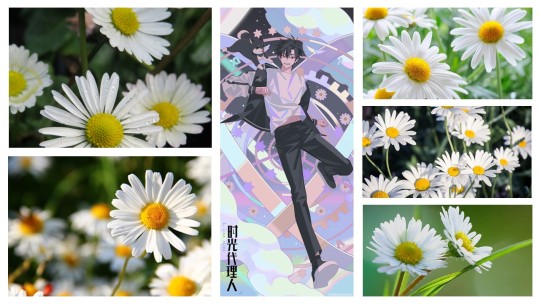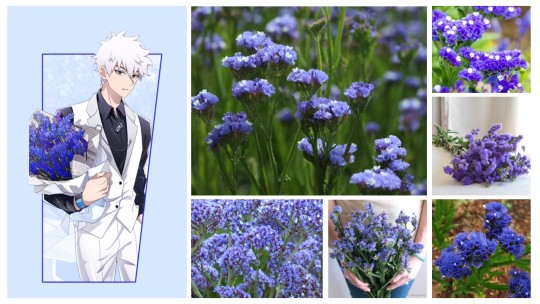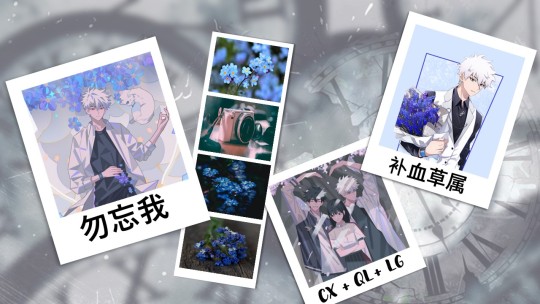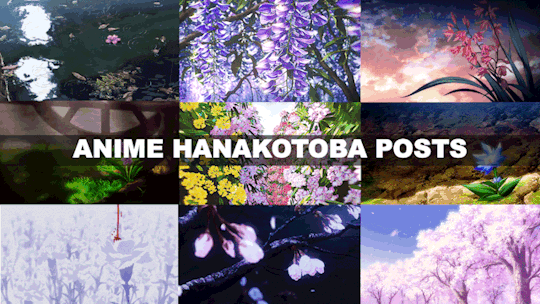#shiguang dailiren hanakotoba
Text
Shiguang Dailiren/Link Click
Hanakotoba Analysis

Cheng Xiaoshi/Toki -> Daisy (Bellis)

Cheng Xiaoshi/Toki’s official flower is the Daisy (Bellis) as pictured on his official birthday artwork. Daisies are known as chú jú (雏菊) in Chinese and hinagiku (雛菊) in Japanese. This flower is associated with the meanings of “innocence”, “devotion”, “justice”, “charity” and “beauty” in English floriography. Its hanakotoba meanings are “peace”, “hope”, “beauty” and “chastity”. In Japanese culture, daisies are also often associated with new beginnings and are thought to bring joy and happiness to those whom it is gifted. In China, the flower is mainly associated with innocence, purity, hope, and new beginnings. Additionally, they can symbolize simplicity, sincerity, springtime, happiness, and new love.
Cheng Xiaoshi is best described as someone with a good heart whose playful, stubborn and impulsive nature can be interpreted by others as being childish and irresponsible. He is extremely sensitive and deeply empathetic with a strong sense of justice. These characteristics paired with his impulsiveness often not only lead to him making decisions with his heart rather than his head—landing not only himself but also those around him in a myriad of tricky situations—but also result in him doing things that are in the best interest of others but are detrimental to himself. These traits tie into the flower’s meanings of justice, charity and devotion. His seemingly boundless optimism and upbeat personality complement the flower’s meanings of joy, happiness, and springtime. When Lu Guang was asked by Qiao Ling, what attracted him to Cheng Xiaoshi, he stated that it was the other’s naivety. This ties into the flower’s meanings of innocence, sincerity, purity and simplicity.
Cheng Xiaoshi has the ability to enter the time of any photo by possessing the body of the person who took the photo. Using this ability, he is able to directly change the events within a 12-hour timeline of the photo (i.e., alter past events). This ties into the daisy’s meanings of new beginnings and hope. Additionally, when using this ability, Cheng Xiaoshi’s eyes turn gold-yellow which corresponds with the yellow-centre of the daisy.
Lu Guang/Hikaru -> Forget-me-not

Lu Guang/Hikaru’s official flower is the forget-me-not as pictured on his official birthday artwork. The forget-me-not (Myosotis) is known as wù wàng wǒ (勿忘我) in Chinese and wasurenagusa (勿忘草) in Japanese. As its name suggests the flower is associated with the meanings of “true love” and “memories” in English floriography. Its Japanese name means “don’t forget me” thus associating the flower with its hanakotoba meanings of “true love” and “remembrance”. In China, the flower is associated with not only true love and memories but also fidelity and faithfulness.
Lu Guang is typically calm, patient, responsible and uptight. Although not always blatantly obvious, Lu Guang cares deeply for his friends and always does things that are in their best interest. Although typically stoic and cautious, when those important to Lu Guang are in danger, he will break his usual calm façade and show anger and concern as well as pull off precarious manoeuvres to save them. These traits tie into the flower’s meanings of faithfulness and fidelity.
Lu Guang has the ability to see everything that happens within a 12-hour timeframe after a photo has been taken. Photographs are able to capture important moments with loved ones in order to be preserved and looked back upon at a later date. Lu Guang
and Cheng Xiaoshi’s abilities rely on photographs and are used to analyse and manipulate memories, respectively. This further links Lu Guang to the forget-me-not flower. Additionally, when using their respective abilities Lu Guang’s eyes turn ice-blue whereas Cheng Xiaoshi’s turn gold-yellow which corresponds with the yellow-centred, blue blossoms of the forget-me-not, respectively.
Click here for further analysis of Lu Guang given new information from season 2.
Qiao Ling/Rin -> Hyacinth

Qiao Ling/Rin’s official flower is the hyacinth as pictured on her official birthday artwork. The hyacinth (Hyacinthus) is known as fēng xìn zǐ (风信子) in Chinese and haiashinsu (ヒヤシンス) in Japanese. The hyacinth is seen as a symbol of sophistication, refinement, grace and elegance in English floriography. It is also known as a symbol of love and passion. It is also sometimes associated with rashness, games and rebirth. Its hanakotoba meanings are friendship, affection and “love beyond sorrow”. The bright colours of hyacinths are said to represent joy and happiness―and is thus seen as a gesture of goodwill when gifted to others in Japanese culture. In China, the flower is associated with good luck and fortune and is thus often used during special occasions and celebrations as an auspicious decoration. It is said that the hyacinth’s bright colours and cheerful blossoms bring prosperity and good luck to those who see it.
Qiao Ling is best described as outspoken, expressive, and compassionate. She deeply trusts those she is close to and is very protective over them. Qiao Ling typically possesses a playful and upbeat personality. These traits tie into the hyacinth’s meanings of joy, passion, friendship and goodwill. Although often seen bickering with Cheng Xiaoshi―she retains an air of gracefulness and ladylikeness and often dresses very stylishly, which fits in with the flower’s meanings of elegance, grace and sophistication.
Official Art Celebrating 400 Million Views

In this official art the flower bouquet that Cheng Xiaoshi is holding might be his official flower the daisy (Bellis) but could also be camomile flowers. Camomile also known as chamomile is a daisy-like plant in the same family as the Bellis genus (Asteraceae family). Camomile is known as yáng gān jú (洋甘菊) in Chinese and kamomīru (カモミール) in Japanese.
In English floriography, the flower represents the concepts of having “patience in adversity” and “energy in adversity”. In hanakotoba, the flower conveys the meanings of “enduring adversity” and the “power to be born in adversity”. Both the English and Japanese meanings derive from the fact that camomile grows like a creeper on the ground and persists even if trampled on―even growing stronger the more it is stepped on. These meanings greatly complement Cheng Xiaoshi’s immense optimism, endurance, and perseverance that persists despite him being faced with difficult circumstances and harsh obstacles.

In this official artwork, Lu Guang isn’t pictured with his official flower, the forget-me-not but is instead pictured with a bouquet of statice. Statice (Limonium) is also known as sea lavender and marsh rosemary despite not being related to either lavender or rosemary. Statice is known as bǔxuè cǎo shǔ (补血草属) in Chinese and sutāchisu (スターチス) in Japanese.
Similarly, to forget-me-nots, this flower is associated with memory and remembrance. In English floriography, this flower represents “longing”, “remembrance”, “success” and “sympathy”. Purple statice in particular represents suppleness and elegance. The hanakotoba meanings associated with statice are “unchanging heart” and “uninterrupted memory”. The vibrant colour of these flowers does not fade even when dried. This attribute has resulted in its hanakotoba meanings “unchanging heart”, “uninterrupted memory”, and “eternal immutability”. These meanings are similar to that of the forget-me-not and consequently complement Lu Guang’s character in a similar manner.
[If you liked this post, check out my other hanakotoba analysis posts here ❀ There are 2 other hanakotoba posts on Link Click on my blog...]
[P.S. If anyone knows which two flowers are in the very first image in this post (i.e., the season 2 key visual), please let me know so I can add them...I couldn't figure it out for the life of me. Also, if I've gotten any of the kanji, romaji, hanzi or pinyin incorrect, feel free to correct me]
#link click#link click season 2#shiguang daili ren#shiguang dailiren#shi guang dai li ren#shiguang#cheng xiaoshi#lu guang#qiao ling#hanakotoba#hanakotoba post#floriography#flower meanings#link click hanakotoba#link click symbolism#anime#donghua#anime symbolism#donghua symbolism#anime analysis#link click official art
115 notes
·
View notes
Text
Shiguang Dailiren/Link Click
Season 2 Key Visual
Hanakotoba Analysis

In the first key visual for season 2 of the donghua, Cheng Xiaoshi and Lu Guang are pictured alongside what seems to be pink periwinkle and spiderwort flowers.
The spiderwort (Tradescantia) is also called the dayflower and is known as zǐ wànniánqīng shǔ (紫万年青属) in Chinese and the shirokusa (紫露草) in Japanese. The spiderwort flower is associated with immortality, optimism, and moral authority in English floriography because of its evergreen foliage and lasting flowers. Its hanakotoba meaning is platonic respect. In China, the spiderwort flower symbolises longevity and good luck. It is also utilised in pain-relieving medicine used to treat diseases. Conversely, the spiderwort flower can also symbolise transient happiness.
The periwinkle (Catharanthus roseus) is also known as the Madagascar periwinkle, Cape periwinkle, or Rose periwinkle. The periwinkle is known as chángchūnhuā (长春花) in Chinese and nichiodoriji kusa (日々草) in Japanese. The periwinkle symbolises faith, trust, everlasting love, and purity in English floriography. This flower is associated with admiration, appreciation, new beginnings, and friendships. Periwinkles can also symbolise tender recollections and sweet or pleasing remembrances. Its hanakotoba meaning is pleasant memories. In China, periwinkles love, passion, nurturing and warmth.
Memories and human relationships are a central part of Link Click as Cheng Xiaoshi and Lu Guang co-own a shop called the Time Photo Studio where they use their powers that let them jump into photographs, live the events of the picture, and resolve past regrets. The deep friendship between its main cast is another central theme in Link Click especially the great lengths Lu Guang and Cheng Xiaoshi are willing to go through to ensure the other’s safety and happiness. This ties in well with the periwinkle’s meanings of tender recollections, sweet or pleasing remembrances, friendships, and new beginnings.
Every time they jump into a photo, they risk changing the past which has ultimately resulted in dire consequences for them both interrupting their halcyon blissful lives and trapping them in a seemingly endless cycle of loss. This ties in well with the spiderwort flower’s contradictory meanings of longevity and transient happiness.
[If you liked this post, check out my other hanakotoba analysis posts here ❀]
[P.S. I didn't want to go into too much detail here since I've already done 2 other hanakotoba analysis posts on Link Click―so if you liked this post then check out those... Also, if I've gotten any of the kanji, romaji, hanzi or pinyin incorrect, feel free to correct me]
#I'm back to obsessing over link click lol...#i finally figured out what flowers those are...at least I think so...#I've got 5 other hanakotoba posts planned from other shows so stay tuned...#link click#shiguang dailiren#anime#donghua#hanakotoba#hanakotoba analysis#link click season 2#shiguang#link click s2#link click hanakotoba#floriography#anime analysis#anime hanakotoba#lu guang#shi guang dai li ren#cheng xiaoshi#shiguang daili ren
50 notes
·
View notes
Text
Shiguang Dailiren/Link Click Hanakotoba Analysis: Lu Guang Omake
Shiguang Dailiren 《Link Click 》 Hanakotoba Analysis
Additional Revisions
Given recent revelations in the newly released episode 24, I have decided to revisit this topic to add some additional information now that we have some more context into Lu Guang's actions and thoughts. I wanted the new material to be easily accessible so that those who have already seen my original post don't have to reread it. So, if you haven't seen it already, please click on the link provided here.

⚠️Warning! Spoilers for Link Click Episode 24/Season 2 Episode 12!⚠️
The forget-me-not not only serves as a powerful symbol of the ties that bind loved ones together but also of the enduring power of love and memories. The forget-me-not is also said to be a symbol of hope and continuity as it is resilient and blooms even under challenging conditions. This flower thus additionally symbolises staying true to oneself.
The final episode of season 2 revealed that Lu Guang comes from a different timeline where Cheng Xiaoshi has died. Cheng Xiaoshi’s death caused Lu Guang to break their rules without hesitation. He lives likely constantly haunted by the memory of Cheng Xiaoshi’s death, despite the latter being alive alongside him in the present moment, while actively trying to prevent his death. The incredible lengths Lu Guang is able to go through for Cheng Xiaoshi ties into the forget-me-not’s meanings of remembrance, enduring love, faithfulness, fidelity, and friendship. Additionally, the forget-me-not’s resiliency and meanings of hope, continuity, and staying true to oneself greatly complement Lu Guang’s dedication and commitment to altering fate.
The statice flower’s meanings of “unchanging heart, uninterrupted memory, and eternal immutability” parallel Lu Guang’s unwavering dedication and perseverance in saving Cheng Xiaoshi no matter the consequences of changing the past well.
[If you liked this post check out my other hanakotoba analysis posts here ❀]
#we don't have all the facts yet so some of this could turn out to be conjectures.#But I had to add this after watching the final episode#here's to hoping we get season 3 soon#link click#shi guang dai li ren#shiguang daili ren#shiguang dailiren#link click season 2#link click donghua#link click s2#anime#donghua#lu guang#shiguang#cheng xiaoshi#Naturally#hanakotoba#hanakotoba analysis#floriography#link click hanakotoba#shiguang dailiren hanakotoba#flower meanings#link click official art
42 notes
·
View notes
Text
╔⏤⏤╝❀╚⏤⏤╗
Anime Hanakotoba Posts Directory
»•» 🌸 ««@frostfires-blog »» 🌸 «•«

1.0 Gintama OP15
2.1 Fruits Basket ED4 P1
2.2 Fruits Basket ED4 P2
3.0 Boku no Hero Academia ED10
4.0 Chihayafuru ED3
5.1 Shiguang Dailiren/Link Click Official Art
5.2 Shiguang Dailiren/Link Click Official Art - Lu Guang Omake
5.3 Shiguang Dailiren/Link Click Season 2 Key Visual
6.0 Shingeki no Kyojin/Attack on Titan ED7
7.1 Bleach P1: OP16 & ED31 ~ Ichigo Kurosaki
7.2 Bleach P2: ED31
7.3 Bleach P3: OP16 & ED31 ~ Gotei 13
8.1 Tiān Guān Cì Fú/Heaven Official's Blessing P1
8.2 Tiān Guān Cì Fú/Heaven Official's Blessing P2
9.0 Jujutsu Kaisen
10.0 Shingeki no Kyojin/Attack on Titan Final ED - Itterasshai
11.0 TBC...
P.S: If you liked any of these posts and there's a particular anime scene, anime opening or anime ending—with some flower symbolism in it—that you want me to do post on, send me an ask and I'll gladly do it if I've seen the show...
╚⏤⏤╗❀╔⏤⏤╝
#anime#hanakotoba#anime hanakotoba#flower symbolism#floriography#gintama#gintama op15#fruits basket#fruits basket 2019#boku no hero academia#bnha#mha#my hero academia#bnha season 6#mha season 6#mha ed10#chihayafuru#chihayafuru anime#shiguang dailiren#link click#snk#aot#attack on titan#shingeki no kyojin#bleach#bleach tybw#tgcf#heaven official's blessing#jjk#jujutsu kaisen
27 notes
·
View notes